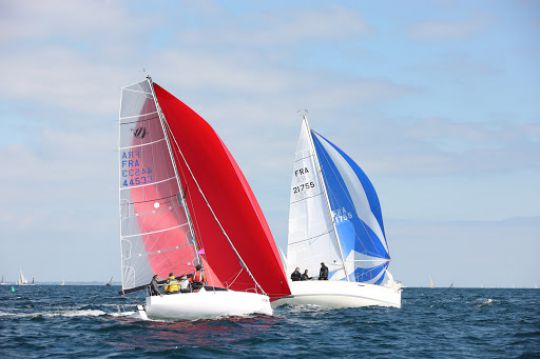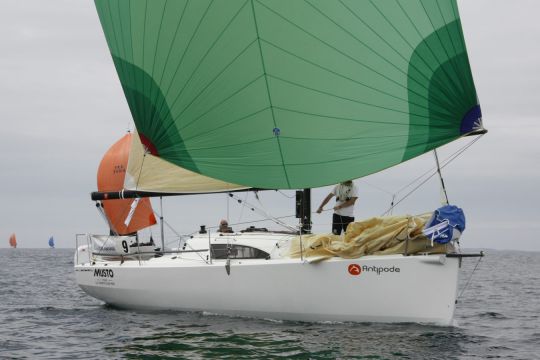It is known that each sail on board has a window of optimal use corresponding to a wind force and angle. Downwind, for example, a symmetrical S5 spinnaker is typically made to sail downwind in the medium (160° TWA, with 15 knots TWS) while an asymmetrical A3 spinnaker is ideal for sailing in a slightly luffy breeze (145° TWA, with 25 knots TWS).

However, there are techniques that allow a spinnaker to be pushed beyond its range of use. To avoid a change of sail or destination, here's how to trim your downwind sails to luff or furl when the wind is not cooperating.
Lofer with a symmetrical spinnaker.

Symmetrical spinnakers are designed to work in "push", full downwind, the sail is offset to the wind thanks to the spinnaker pole. Thus, it is better exposed to the wind, far from the vortices of the mainsail.
However, when you need to luff, you can adjust your symmetrical spinnaker to work a bit like an asymmetrical one. Start by orienting the spinnaker pole forward with the "spinnaker pole arm" and stretch it down with the pole downhaul. Then take the windward barber fully and release the leeward barber.
With the spinnaker pole pointing forward, place the spinnaker pole tack in the axis of the boat, as would a bowsprit. Lowering the spinnaker pole tightens the guide so that it works like the leading edge of an asymmetric spinnaker. The tighter your angle to the wind, the closer the pole should be to the forestay. But be careful, you must control the pole with the "arm" to prevent it from crashing into the forestay even in gusty conditions.
Once the spinnaker pole is correctly positioned, lock the pole arm to the winch or cleat. You can now use or adjust the sail as an asymmetric spinnaker. Release the sheet until you can see the luff unfurling, then tack a little to re-inflate it. If you tuck in the symmetrical spinnaker as tightly as possible, it will act almost like a code zero. The symmetrical spinnaker is a very versatile sail.
Sailing very low with an asymmetric spinnaker

Asymmetrical spis are designed to be easier to adjust when you loosen up a little. They are designed to work with a laminated airflow like flat sails. They are easy to use, but their shape limits the angle of descent to the point where they are very unsuitable for downwind conditions
However, when it is necessary to sail lower than the optimum angle, there are some simple adjustments to adopt. Start by loosening the tack a little to increase luff length and make the shape of the sail more hollow.
Releasing the tack also allows the sail to turn around the forestay. While the helmsman is lowering, the trimmer still has to release the spinnaker sheet, which results in even more rotation of the spinnaker around the forestay. The spinnaker comes upwind, so to speak, which takes it away from the eddies of the mainsail, so you can sail more downwind.
However, in this configuration the asymmetric spinnaker is unstable, so it will be necessary to be reactive and coordinated with the helm and the settings. Avoid going too low, because if the spinnaker deflates it will take a long time to re-inflate correctly. It will be necessary to luff and reef the sail, this is not a problem in itself, but it is the opposite of the desired effect.

Knowing how to adapt when conditions require luffing or lowering with an inappropriate sail is often a useful skill. Because each boat is rigged differently, you will need to adjust to the specifics of your sailboat. These tips will be useful for a first approach, you will have to increase your knowledge by testing your own boat.










